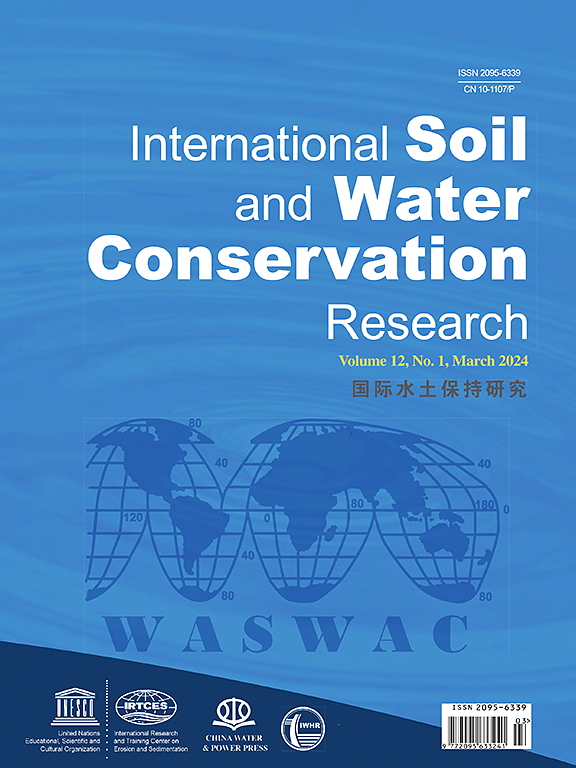The potential of runoff retention structures as a strategy to control urban gullying in tropical cities
IF 7.3
1区 农林科学
Q1 ENVIRONMENTAL SCIENCES
International Soil and Water Conservation Research
Pub Date : 2024-11-13
DOI:10.1016/j.iswcr.2024.11.002
引用次数: 0
Abstract
Rapid and chaotic urbanization leads to the formation of urban gullies in many tropical cities of the Global South. To prevent and limit the destructive impacts of these gullies, runoff retention structures are often constructed. Yet, earlier research indicates that these measures are largely ineffective in reducing urban gully expansion. This study aims to understand why. We conducted detailed field surveys in two representative catchments affected by urban gullies in Kinshasa (Democratic Republic of the Congo) and characterized all existing runoff retention structures. We then used the Soil Water Management Model (SWMM) to evaluate the likely influence of these structures on runoff volumes and peak discharges. Although most parcels (77%–88%) in the catchments have at least one runoff retention structure, their overall effect catchment runoff is limited (e.g., only 25–30% reduction of the total runoff volume for an event with a return period of 2 years). One key reason is that many structures are too small and poorly maintained, reducing their already limited storage capacities. Additionally, they are typically unequally distributed within the catchments (with fewer measures upstream) and not proportional to the parcel size, leading to some oversized and many undersized structures. Overall, we demonstrate that, while current efforts are largely ineffective, coordinated implementations of runoff retention structures proportional to parcel size offer promising perspectives for better controlling urban gully erosion.
径流截留结构作为控制热带城市沟壑区策略的潜力
在全球南方的许多热带城市,快速而混乱的城市化导致了城市沟壑的形成。为了防止和限制这些沟渠的破坏性影响,经常建造径流截流结构。然而,早期的研究表明,这些措施在减少城市沟壑扩张方面基本上是无效的。本研究旨在了解其中的原因。我们在金沙萨(刚果民主共和国)两个受城市沟渠影响的代表性集水区进行了详细的实地调查,并对所有现有的径流保留结构进行了表征。然后,我们使用土壤水管理模型(SWMM)来评估这些结构对径流量和峰值流量的可能影响。虽然汇水区的大多数地块(77%-88%)至少有一个径流保留结构,但它们对汇水区径流的总体影响是有限的(例如,在一个2年的回收期中,仅减少总径流量的25-30%)。一个关键原因是许多结构太小,维护不善,减少了它们本就有限的存储容量。此外,它们通常在集水区内分布不均(上游测量较少),与地块大小不成比例,导致一些过大和许多较小的结构。总的来说,我们证明,虽然目前的努力在很大程度上是无效的,但与地块大小成比例的径流保留结构的协调实施为更好地控制城市沟壑侵蚀提供了有希望的前景。
本文章由计算机程序翻译,如有差异,请以英文原文为准。
求助全文
约1分钟内获得全文
求助全文
来源期刊

International Soil and Water Conservation Research
Agricultural and Biological Sciences-Agronomy and Crop Science
CiteScore
12.00
自引率
3.10%
发文量
171
审稿时长
49 days
期刊介绍:
The International Soil and Water Conservation Research (ISWCR), the official journal of World Association of Soil and Water Conservation (WASWAC) http://www.waswac.org, is a multidisciplinary journal of soil and water conservation research, practice, policy, and perspectives. It aims to disseminate new knowledge and promote the practice of soil and water conservation.
The scope of International Soil and Water Conservation Research includes research, strategies, and technologies for prediction, prevention, and protection of soil and water resources. It deals with identification, characterization, and modeling; dynamic monitoring and evaluation; assessment and management of conservation practice and creation and implementation of quality standards.
Examples of appropriate topical areas include (but are not limited to):
• Conservation models, tools, and technologies
• Conservation agricultural
• Soil health resources, indicators, assessment, and management
• Land degradation
• Sustainable development
• Soil erosion and its control
• Soil erosion processes
• Water resources assessment and management
• Watershed management
• Soil erosion models
• Literature review on topics related soil and water conservation research
 求助内容:
求助内容: 应助结果提醒方式:
应助结果提醒方式:


